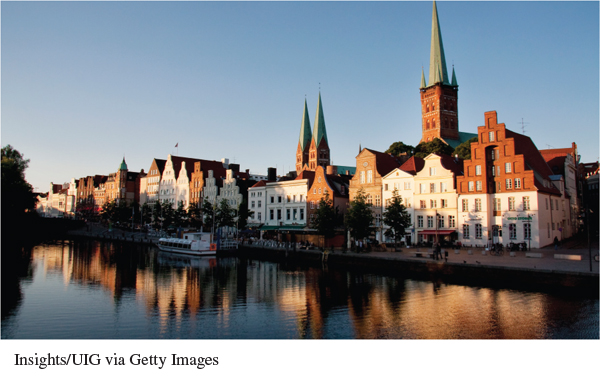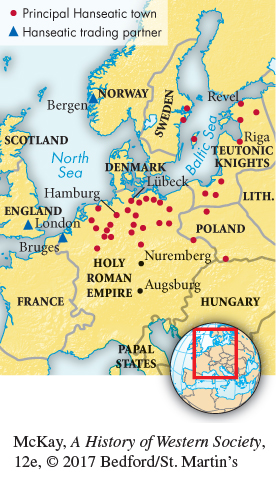A History of Western Society: Printed Page 301
A History of Western Society, Value Edition: Printed Page 291
A History of Western Society, Concise Edition: Printed Page 303
Business Procedures
The economic surge of the High Middle Ages led merchants to invent new business procedures. Beginning in Italy, merchants formalized their agreements with new types of contracts, including temporary contracts for land and sea trading ventures and permanent partnerships termed compagnie (kahm-

The ventures of the German Hanseatic League illustrate these new business procedures. The Hanseatic League (often called simply the Hansa) was a mercantile association of towns. It originated in agreements between merchants for mutual security and exclusive trading rights, and it gradually developed into agreements among towns themselves, often sealed with a contract. The first such contract was between the towns of Lübeck and Hamburg in 1241, and during the next century perhaps two hundred cities from Holland to Poland joined the league. From the fourteenth to the sixteenth centuries, the Hanseatic League controlled the trade of northern Europe. In cities such as Bruges and London, Hansa merchants secured special trading concessions, exempting them from all tolls and allowing them to trade at local fairs. These merchants established foreign trading centers, called “factories” because the commercial agents in them were called “factors.”

The dramatic increase in trade ran into two serious difficulties in medieval Europe. One was the problem of minting money. Despite investment in mining operations to increase the production of metals, the amount of gold, silver, and copper available for coins was not adequate for the increased flow of commerce. Merchants developed paper bills of exchange, in which coins or goods in one location were exchanged for a sealed letter (much like a modern deposit statement), which could be used in place of metal coinage elsewhere. This made the long, slow, and very dangerous shipment of coins unnecessary, and facilitated the expansion of credit and commerce. By about 1300 the bill of exchange was the normal method of making commercial payments among the cities of western Europe, and it proved to be a decisive factor in their later economic development.
The second problem was a moral and theological one. Church doctrine frowned on lending money at interest, termed usury (YOO-
The stigma attached to lending money was in many ways attached to all the activities of a merchant. Medieval people were uneasy about a person making a profit merely from the investment of money rather than labor, skill, and time. Merchants themselves shared these ideas to some degree, so they gave generous donations to the church and to charities, and took pains not to flaunt their wealth through flashy dress and homes.